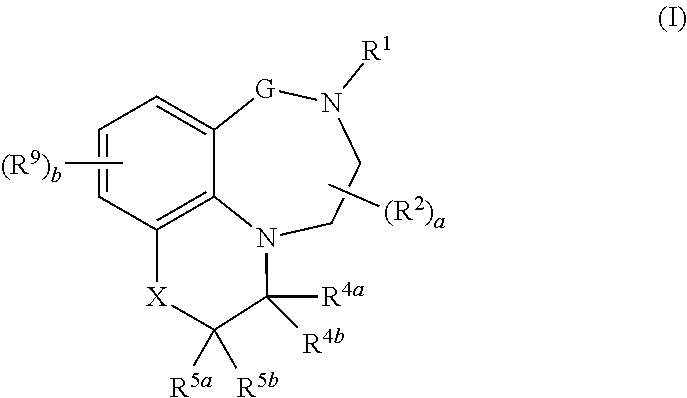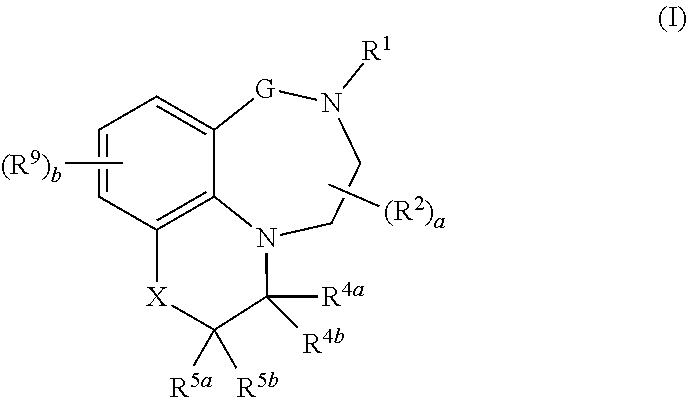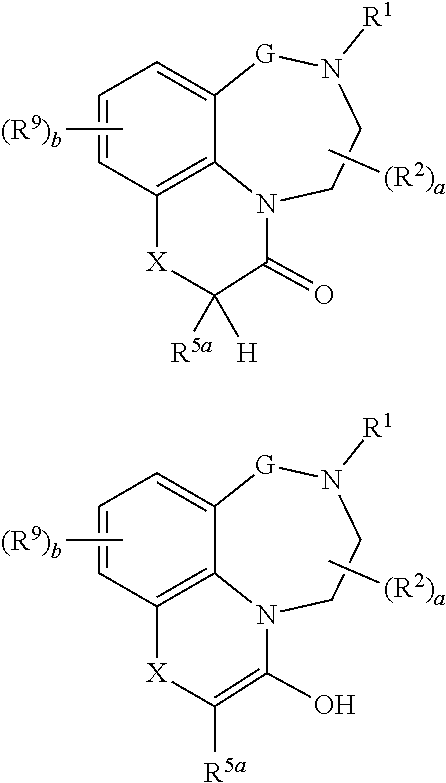Tricyclic quinoline and quinoxaline derivatives
a technology which is applied in the field of tricyclic quinoline and quinoxaline derivatives, can solve the problems of limiting therapeutic efficacy, affecting patient compliance, and atypical antipsychotics lacking robust efficacy against negative and cognitive components of schizophrenic syndrom
- Summary
- Abstract
- Description
- Claims
- Application Information
AI Technical Summary
Benefits of technology
Problems solved by technology
Method used
Image
Examples
examples
[0365]The compounds were either characterized via proton-NMR in d6-dimethylsulfoxide or d-chloroform on a 400 MHz or 500 MHz NMR instrument (Bruker AVANCE), or by mass spectrometry, generally recorded via HPLC-MS in a fast gradient on C18-material (electrospray-ionisation (ESI) mode), or melting point.
[0366]The magnetic nuclear resonance spectral properties (NMR) refer to the chemical shifts (δ) expressed in parts per million (ppm). The relative area of the shifts in the 1H-NMR spectrum corresponds to the number of hydrogen atoms for a particular functional type in the molecule. The nature of the shift, as regards multiplicity, is indicated as singlet (s), broad singlet (s. br.), doublet (d), broad doublet (d br.), triplet (t), broad triplet (t br.), quartet (q), quintet (quint.) and multiplet (m).
[0367]Enantiomers were separated / purified either by chiral supercritical fluid chromatography (SFC) (method A) or by chiral HPLC (method A).
Method A—Chiral Analytical SFC
[0368]Analytical S...
preparation examples
I. Preparation Examples
Example 1
[0379]8,8-Dimethyl-2,3,4,6,7,8-hexahydro-1H-[1,4]diazepino[6,7,1-ij]quinoline (compound of the formula I.g, I.h or I.i in which the combination of R5a, R5b, R7, R8 and R9a is as in row B-1 of Table B)
1.1 Preparation of tert-butyl 1-(3-methylbut-2-enoyl)-2,3-dihydro-1H-benzo[e][1,4]diazepine-4(5H)-carboxylate
[0380]1 g (4.04 mmol) of tert-butyl 2,3-dihydro-1H-benzo[e][1,4]diazepine-4(5H)-carboxylate was dissolved in 20 mL of dichloromethane and treated with 1.54 mL (8.86 mL) of triethylamine followed by 0.53 mL (4.83 mmol) of 3-methylbut-2-enoyl chloride. The reaction mixture was stirred over night at room temperature, poured onto water (50 mL) and extracted three times with 50 mL of dichloromethane each. The organic phases were combined, washed with a saturated solution of sodium chloride, dried over magnesium sulfate and concentrated in vacuo. The residue was purified by column chromatography on silica (eluent: 5-10% methanol in dichloromethane) to yi...
example 2
[0389]1,2,3,4-Tetrahydrospiro[[1,4]diazepino[6,7,1-ij]quinoline-8,1′-cyclopent[2]en]-6(7H)-one 2,2,2-trifluoroacetate (compound of the formula I.j, I.k or I.l in which the combination of R5a, R5b, R7, R8 and R9a is as in row B-401 of Table B)
2.1 Preparation of tert-butyl 6-oxo-3,4,6,7-tetrahydrospiro[[1,4]diazepino[6,7,1-ij]quinoline-8,1′-cyclopent[2]ene]-2(1H)-carboxylate (compound of the formula I.g, I.h or I.i in which the combination of R5a, R5b, R7, R8 and R9a is as in row B-401 of Table B, wherein however R1 is not H, but Boc)
[0390]A solution of 50 mg (0.128 mmol) tert-butyl 9-chloro-1-(2-cyclopentenylacetyl)-2,3-dihydro-1H-benzo[e][1,4]diazepine-4(5H)-carboxylate was dissolved in 1 mL of degassed dry acetonitrile under argon, treated with 1.4 mg (0.006 mmol) of palladium acetate, 6.10 mg (0.013 mmol) dicyclohexyl(2′,4′,6′-triisopropylbiphenyl-2-yl)phosphine and 53 mg (0.384 mmol) potassium carbonate. The mixture was stirred for 10 hours at 120° C. in a synthesis microwave sys...
PUM
| Property | Measurement | Unit |
|---|---|---|
| flow rate | aaaaa | aaaaa |
| outlet pressure | aaaaa | aaaaa |
| temperature | aaaaa | aaaaa |
Abstract
Description
Claims
Application Information
 Login to View More
Login to View More - R&D
- Intellectual Property
- Life Sciences
- Materials
- Tech Scout
- Unparalleled Data Quality
- Higher Quality Content
- 60% Fewer Hallucinations
Browse by: Latest US Patents, China's latest patents, Technical Efficacy Thesaurus, Application Domain, Technology Topic, Popular Technical Reports.
© 2025 PatSnap. All rights reserved.Legal|Privacy policy|Modern Slavery Act Transparency Statement|Sitemap|About US| Contact US: help@patsnap.com



